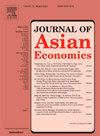Dependence and hedging between green bonds and clean energy sub-markets in China: Insights from time–frequency wavelet approaches
IF 2.9
3区 经济学
Q1 ECONOMICS
引用次数: 0
Abstract
This paper examines the time–frequency dependence between green bonds and clean energy subsector stocks in China, as well as the diversification strategies of relevant investors. Furthermore, this paper considers the impact of the pandemic on diversification strategies. Based on the wavelet coherence and wavelet phase difference analysis, the results indicate that the dependence among green bonds and clean energy varies significantly across scales and clean energy stock market sub-sectors. Besides, various clean energy subsector stocks lead green bonds in the long term. Then, this paper applies the wavelet-transformed data to estimate hedge ratios and hedge effectiveness at different wavelet scales. The clean energy categories and the investment horizon would affect the cost and hedging effectiveness when hedging clean energy stocks with green bonds, and the hedging effectiveness rises with the increase of the scales. Furthermore, the hedging costs vary significantly with various subsector stocks at all investment horizons in the aftermath of the pandemic. These results contribute to environmentally friendly investors and policymakers by considering the clean energy sub-categories at different frequencies.
中国绿色债券与清洁能源子市场之间的依赖与对冲:时频小波方法的启示
本文考察了中国绿色债券与清洁能源板块股票的时频相关性,以及相关投资者的多元化投资策略。此外,本文还考虑了大流行对多样化战略的影响。基于小波相干性和小波相位差分析的结果表明,绿色债券与清洁能源之间的依赖关系在不同规模和清洁能源股票市场细分行业之间存在显著差异。此外,各种清洁能源板块股票长期引领绿色债券。然后,利用小波变换后的数据估计不同小波尺度下的对冲比率和对冲有效性。清洁能源类别和投资期限会影响清洁能源股票与绿色债券套期保值的成本和套期保值效果,且套期保值效果随规模的增大而增大。此外,在大流行之后的所有投资范围内,不同分部门股票的对冲成本差异很大。这些结果有助于环境友好型投资者和政策制定者考虑不同频率的清洁能源子类别。
本文章由计算机程序翻译,如有差异,请以英文原文为准。
求助全文
约1分钟内获得全文
求助全文
来源期刊

Journal of Asian Economics
ECONOMICS-
CiteScore
4.70
自引率
9.40%
发文量
90
期刊介绍:
The Journal of Asian Economics provides a forum for publication of increasingly growing research in Asian economic studies and a unique forum for continental Asian economic studies with focus on (i) special studies in adaptive innovation paradigms in Asian economic regimes, (ii) studies relative to unique dimensions of Asian economic development paradigm, as they are investigated by researchers, (iii) comparative studies of development paradigms in other developing continents, Latin America and Africa, (iv) the emerging new pattern of comparative advantages between Asian countries and the United States and North America.
 求助内容:
求助内容: 应助结果提醒方式:
应助结果提醒方式:


